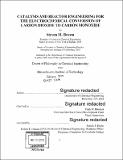| dc.contributor.advisor | Fikile R. Brushett. | en_US |
| dc.contributor.author | Brown, Steven M.(Steven Michael) | en_US |
| dc.contributor.other | Massachusetts Institute of Technology. Department of Chemical Engineering. | en_US |
| dc.date.accessioned | 2020-04-13T18:28:19Z | |
| dc.date.available | 2020-04-13T18:28:19Z | |
| dc.date.copyright | 2019 | en_US |
| dc.date.issued | 2019 | en_US |
| dc.identifier.uri | https://hdl.handle.net/1721.1/124584 | |
| dc.description | Thesis: Ph. D., Massachusetts Institute of Technology, Department of Chemical Engineering, 2019 | en_US |
| dc.description | Cataloged from PDF version of thesis. | en_US |
| dc.description | Includes bibliographical references (pages 163-176). | en_US |
| dc.description.abstract | Carbon dioxide (CO₂) utilization processes have garnered significant interest to both mitigate anthropogenic greenhouse gas emissions and increase the revenue of many chemical and fuel production processes. Low-cost renewable electricity provides impetus for exploring electrochemical methods to recycle CO₂ in cost-competitive and sustainable ways. Researchers have experimentally demonstrated CO₂ transformations into a variety of industrially relevant materials. Techno-economic assessments inform that the simplest transformations, such as generation of carbon monoxide (CO), appear to be the most feasible in the near future. Yet, widespread commercialization of this nascent technology has not occurred due to a number of challenges that include synthesizing stable and active catalyst materials, understanding activity-Ưdriving force relationships, identifying appropriate reactor configurations, and developing comprehensive process models. | en_US |
| dc.description.abstract | This thesis advances both the experiment and theory of CO₂ conversion to CO through electrocatalysis and reactor engineering. A flow reactor was designed and manufactured to understand CO2 reduction in ways that traditional, batch, electroanalytical devices cannot. A key advantage is that, through the use of porous carbon electrodes, the reactor converts gaseous CO₂ to CO at the catalyst-electrolyte interface in a continuous fashion, alleviating the mass transport limitations common to liquid-phase CO₂ delivery systems. To facilitate this transformation, a carbon-supported gold nanoparticle catalyst was synthesized and deposited onto gas diffusion electrodes. These nanoparticles achieved high selectivity (>90%) to CO formation over the competing hydrogen evolution side reaction. | en_US |
| dc.description.abstract | Traditional electrokinetic analyses (e.g., Tafel) were largely unsuccessful at describing the observed current-potential relationship, prompting a rigorous follow-up study on electrokinetics wherein Marcus theory and mass transport convolution, amongst other considerations, were explored. Bayesian statistics concluded that, despite the ubiquitous implementation of Butler-Volmer kinetics in literature, in actuality, a Marcus-Hush-Chidsey model provides the most accurate description of the electrochemical reduction of CO₂ to CO. The implications of this result are significant, potentially resulting in order of magnitude differences in current density projections at high overpotentials. | en_US |
| dc.description.abstract | Overall, this thesis experimentally measured catalysis rates in a specialized electrochemical flow cell, unimpeded by mass transport, and leveraging these results, as well as those from prior literature, advanced electrokinetic descriptions of CO₂ conversion all towards furthering the commercial prospects of this electrochemical technology. | en_US |
| dc.description.statementofresponsibility | by Steven M. Brown. | en_US |
| dc.format.extent | 176 pages | en_US |
| dc.language.iso | eng | en_US |
| dc.publisher | Massachusetts Institute of Technology | en_US |
| dc.rights | MIT theses are protected by copyright. They may be viewed, downloaded, or printed from this source but further reproduction or distribution in any format is prohibited without written permission. | en_US |
| dc.rights.uri | http://dspace.mit.edu/handle/1721.1/7582 | en_US |
| dc.subject | Chemical Engineering. | en_US |
| dc.title | Catalysis and reactor engineering for the electrochemical conversion of carbon dioxide to carbon monoxide | en_US |
| dc.type | Thesis | en_US |
| dc.description.degree | Ph. D. | en_US |
| dc.contributor.department | Massachusetts Institute of Technology. Department of Chemical Engineering | en_US |
| dc.identifier.oclc | 1149013869 | en_US |
| dc.description.collection | Ph.D. Massachusetts Institute of Technology, Department of Chemical Engineering | en_US |
| dspace.imported | 2020-04-13T18:27:50Z | en_US |
| mit.thesis.degree | Doctoral | en_US |
| mit.thesis.department | ChemEng | en_US |
